Page Contents
The Catholic Church has always seen the potential of art and music to draw people to God, as well as to express some of God’s beauty. The material and cultural heritage of the Church is a monument to the faith of its creators and a reminder of eternity.
Church architecture
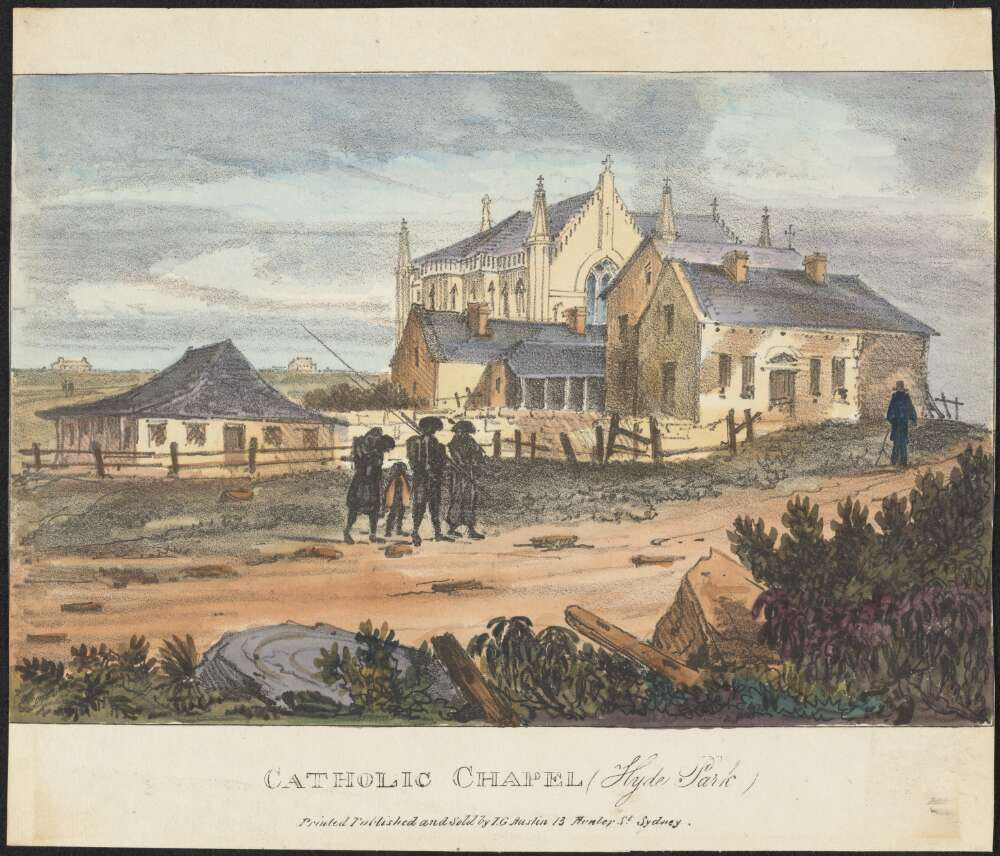
(Robert Russell, nla.obj-135314340)
Soon after the first officially-approved priests arrived in Sydney in 1820, a meeting was held to plan the first church. (Another image) Progress was slow but it was usable in the 1830s. It burned down in 1865.
The oldest surviving Catholic churches are St Brigid’s in The Rocks, Sydney (1834-5) and St John’s, Richmond, Tasmania, completed in 1837.
A number of early churches in Australia were in the style of the leader of the Gothic revival in England, Augustus Pugin. His disciple William Wardell designed Australia’s two premier Catholic cathedrals, St Patrick’s Melbourne and the new St Mary’s Sydney. St Mary’s, begun in 1865 and completed in 1928 except for the spires (added in 2000) is a magnificent cathedral of Sydney sandstone in an approximately French medieval style.

The very rapid development of Melbourne, including the building of St Patrick’s, the largest 19th-century cathedral in the world, is chronicled in The Invention of Melbourne. (review)
An impressive cathedral was built in Perth, despite its small number of Catholics. Brisbane’s Holy Name Cathedral would have been the largest church in the Southern Hemisphere but work was abandoned in 1935.
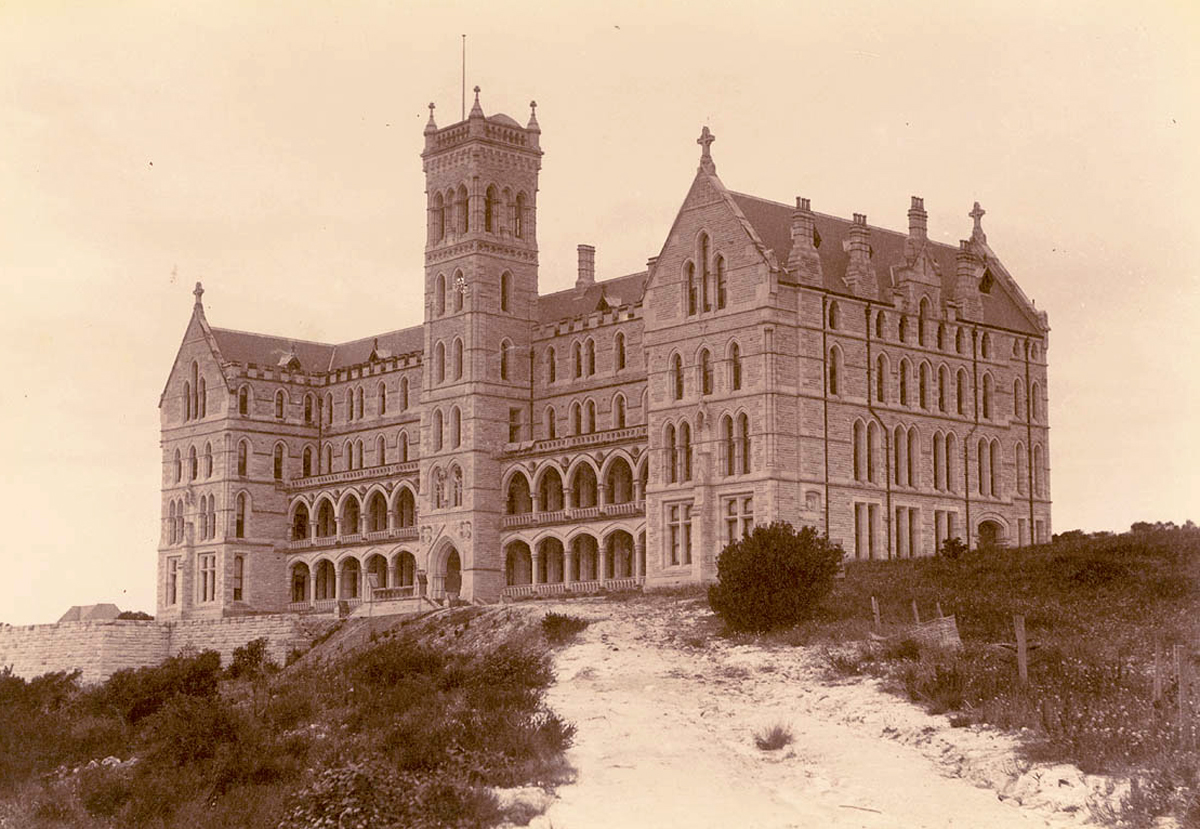
(Star Photo; State Library of New South Wales)
Around 1900 the firm of Sheerin and Hennessy designed a number of spectacular ecclesiastical buildings in Sydney, including St Patrick’s Seminary, Manly, St Joseph’s College, Hunters Hill and the Sacred Heart Monastery, Kensington, as well as St Mary’s Cathedral, Armidale.

Regional areas with small populations also produced some outstanding churches, such as those of Edward Gell in the Bathurst diocese, those in the Monaro region, and those designed by Fr John Hawes in the Geraldton area. Many parishes can look back on a century more of a strong parish community centred on an elegant church building, as with Nanango’s centenary.
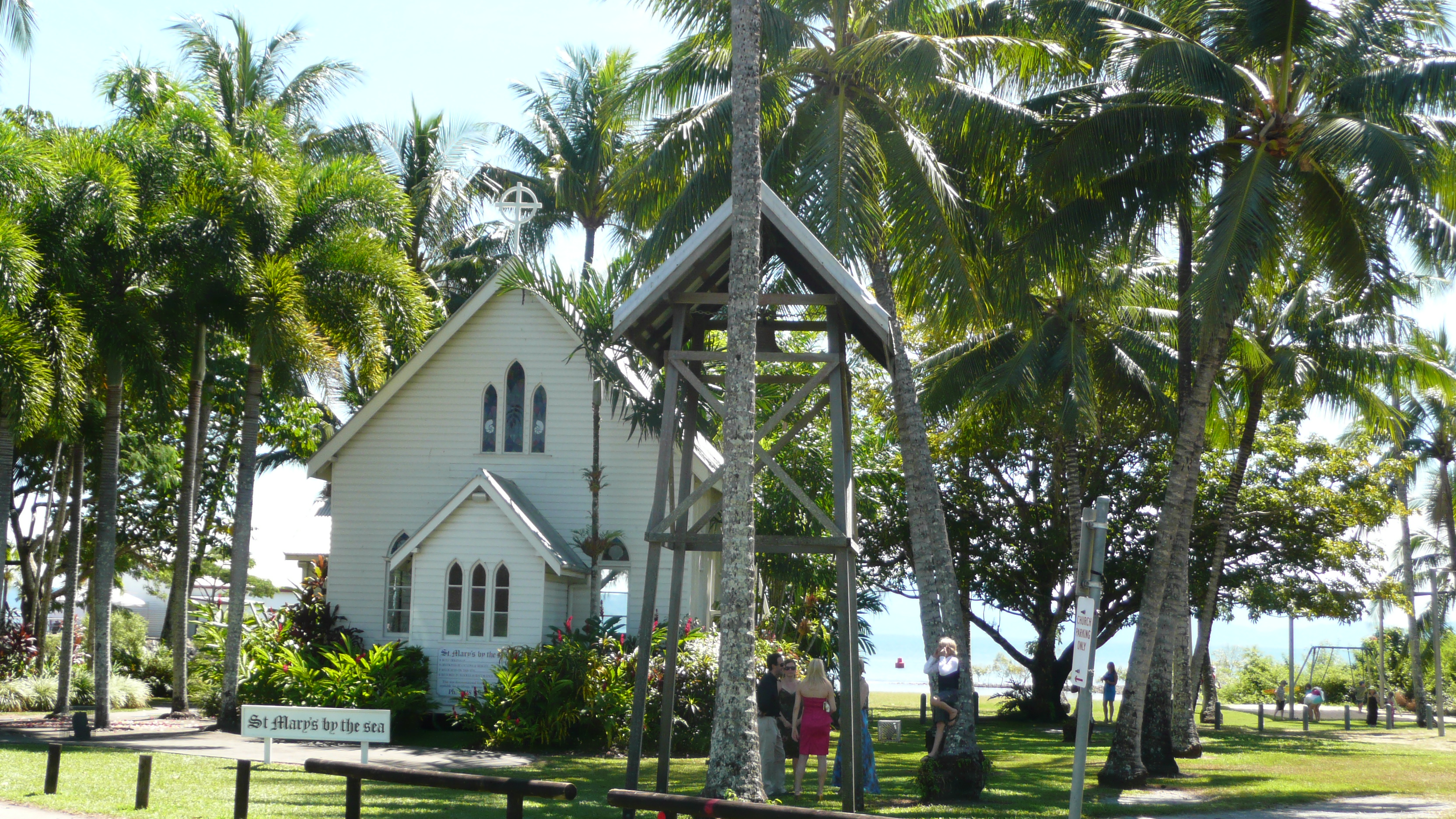
(Kgbo, Wikimedia Commons)
At the opposite end to the spectrum to the grand cathedrals, remote Australia is dotted with many small churches that testify to the faith of their builders and fit into their unique landscapes, such as St Mary’s by the Sea, Port Douglas, the former mission of Santa Teresa, NT, and the one at the top of this page, the tiny St Carthages, Silverton. Some were basic sheds, such as Girilambone.
The Australian Christian Heritage site has pictures and basic historical information on a large number of churches. The Catholic culture in Australia Facebook page contains many pictures of Australian Catholic churches. The Wikipedia category Roman Catholic Churches in Australia lists articles on many churches.
New Norcia and “Catholic complexes”

(Michal Lewi, Wikimedia Commons)
New Norcia north of Perth is Australia’s only monastic town. Founded by Spanish Benedictines in 1847, it contains an abbey, church, girls’ and boys’ colleges, a hostel and ancillary buildings.
On a smaller scale, many older suburbs and country towns contained a “Catholic complex”, with church, presybtery, convent and schools. Often the convent was the most architecturally imposing building in the district and dominated the streetscape. One of the oldest examples is Villa Maria, Hunters Hill, one of the most remote is the heritage-listed St Ignatius’ church and convent in Bourke. The impressive Brigidine Convent, Coonamble was moved to the Hunter Valley and restored as luxury accommodation. The Convent of the Sacred Heart, Rose Bay is a grand building imposingly sited above Sydney Harbour.
Church interiors and stained glass
The interior of a church creates a peaceful and reverent setting for the mass. Stained glass windows tell stories of the Bible and the saints as well as softening and colouring the interior light.

Among the most elaborate are St Mary’s Cathedral’s 1880s windows by Hardman Studios. St Patrick’s Melbourne has an extensive cycle of biblical themes. The stained glass of St Patrick’s Seminary Manly matched its imposing exterior.
Many smaller churches contain gems of stained glass. Examples are those of St James’ Church, Forest Lodge, Sydney.
Probably Australia’s best-known church interior, as well as one of the most remote, is Beagle Bay mission, famed for its pearl-shell altar.
After the Second Vatican Council, many church interiors were remade in a modern style, often regarded as vandalism by admirers of tradition. A well-restored older-style church is St Patrick’s Church Hill, Sydney, the home church of the Australian Catholic Historical Society.
A successful church interior in a contemporary style is the MacKillop Chapel, ACU, Melbourne.
Orphanages, care homes and hospitals
Institution-based care of the sick and disadvantaged has been a core part of the Catholic mission, beginning with the Roman Catholic Orphan School that was established at Parramatta in the 1840s. The massive Abbotsford Convent in Melbourne was said to be the largest charitable institution in the Southern Hemisphere around 1900.
The best-known Catholic hospitals are the Sisters of Charity’s St Vincent’s in Sydney and Melbourne. Nuns ran the mid-twentieth-century leprosaria in remote northen Australia.
See the page on Australian Catholic Charities.
Painting
Justin O’Brien‘s paintings on biblical themes resembled late medieval Italian treatments of the same subjects. His The Virgin Enthroned won the first Blake Prize for religious art in 1951
In a more abstract style, John Coburn “sought a confluence of Western European culture, the Roman Catholic religion, Aboriginal spirituality and nature.” John Ogburn said his painting was inspired by Dr Woodbury’s Thomist philosophy.
After his conversion, Roy De Maistre painted a number of religious works, such as the Stations of the Cross in Westminster Cathedral. Arthur Boyd, not himself Catholic, found inspiration in the story of St Francis as well as in Biblical themes.
Salvatore Zofrea’s Catholic heritage is evident in his series on the Psalms and his windows of St Gregory’s Church, Kurrajong.

Paul Newton’s Our Lady of the Southern Cross in St Mary’s Cathedral and a series in Domus Australia, Rome have proved popular.
In 1997 the Supreme Court of Victoria declined to grant an injunction sought by Cardinal Pell to prevent the National Gallery of Victoria from exhibiting Piss Christ, a photograph of a crucifix in a tank of urine. A controversy on “artistic freedom” ensued.
Renderings of a black Madonna include those of Karel Kupka and Richard Campbell. Marjorie Liddy’s indigenous bird image was used on the vestments at World Youth Day 2008.
See also the website of Australian Catholic Liturgical Art.
Sculpture
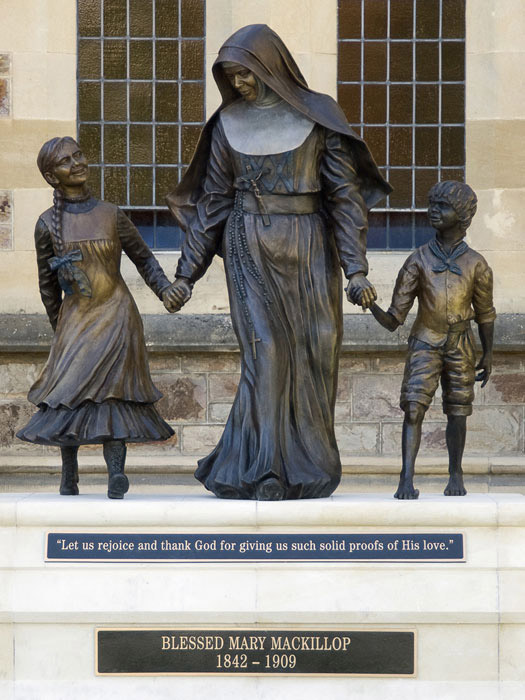
Mary MacKillop has been a popular subject, with statues in Fitzroy, Melbourne General Cemetery, Werribee, Adelaide, Brisbane, North Sydney and outside St Mary’s Cathedral, Sydney.
The statues of St Patrick’s Melbourne honour a very diverse group: Mannix, Daniel O’Connell “The Liberator”, St Francis of Assisi and St Catherine of Siena, Mary MacKillop and Cardinal Stepinac. The statues of Cardinal Moran and Archbishop Kelly outside St Mary’s, Sydney are of a size matching the devotion once felt for prelates.
In a more modernist style are Tom Bass’s sculptures in St Augustine’s, Yass. Peter Schipperheyn’s sculptures include the stations of the cross at Notre Dame University, Fremantle.
Major events
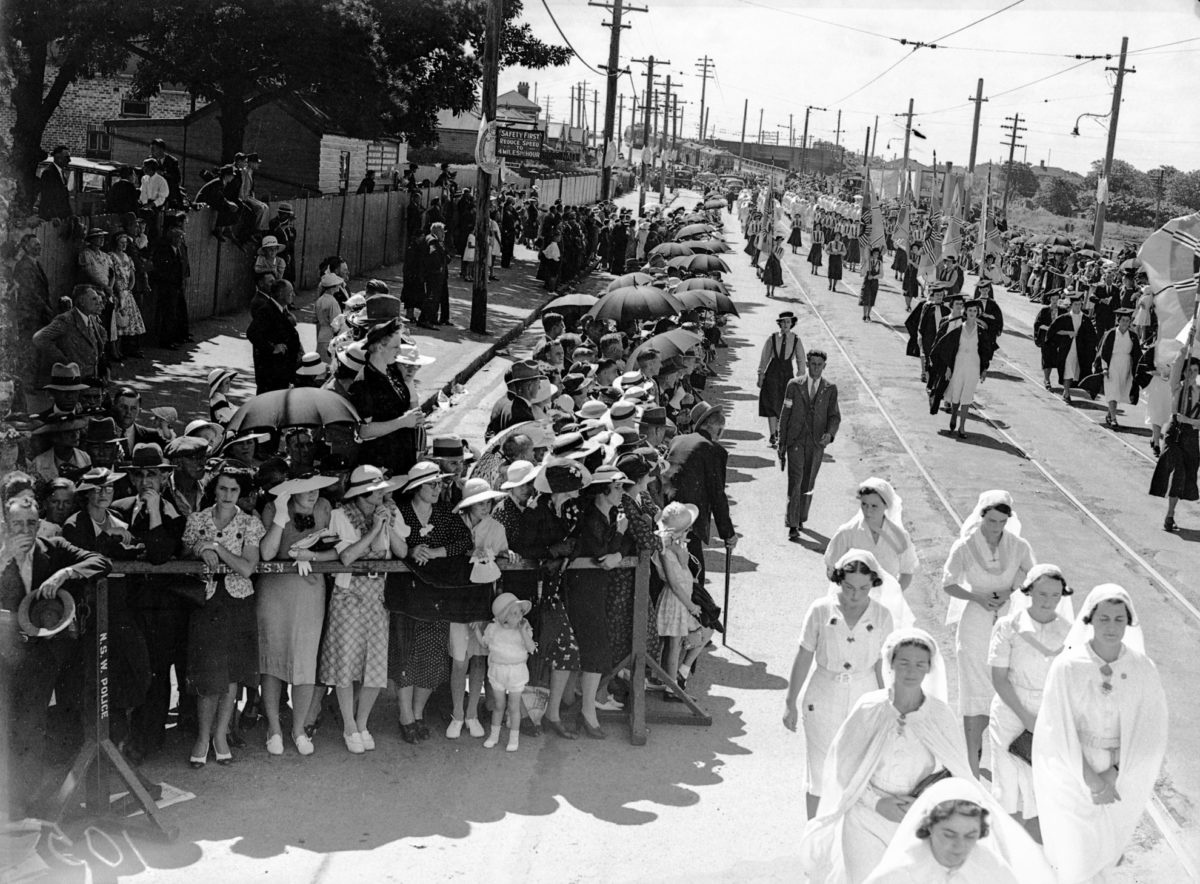
While some competing ideologies were indulging in mass rallies and May Day parades, the Catholic Church too staged massive public gatherings, such as the International Eucharistic Congress, Sydney, 1928, (booklet) the National Eucharistic Congress, Melbourne, 1935 (video) and the Eucharistic Congress, Newcastle, 1938.
The papal visits of 1970, 1986 and 2008 were huge events – see the newsreel footage on the Podcasts and videos page.
Drama
Peter Kenna’s A Hard God (1973) and Ron Blair’s The Christian Brothers (1975) concentrated on the harsher aspects of Catholic life, as did Nick Enright’s works based on his time at Riverview College, such as the TV episode Coral Island and play St James Infirmary. Veronica Brady examines the genre in her book Playing Catholic.
Tensions in convents provide a ready source of drama, as in Robert Wales’ 1966 play, The Cell.
More affectionate was Barry Oakley’s 1971 box office success, the boisterous farce The Feet of Daniel Mannix. Particularly memorable is the meeting of “Doctor Manic of Mellerbrun” with Pope Benedict XV.
Melvyn Morrow‘s plays include Her Holiness, a somewhat sceptical view of Mary MacKillop, Vice, on sexual abuse allegations in a school, and Acts of Faith, on nuns and real estate.
The 1990 musical Bran Nue Dae is set in a surreal version of Catholic missions. (trailer of the movie)
Sydney Theatre Company’s major 2018 production of The Harp in the South brought to life Ruth Park‘s novels of a poor Irish Catholic community of the 1940s.

Sydney’s amateur Genesian Theatre was founded by members of the Catholic Youth Organisation in 1944. Since 2005, the Sydney association Artes Christi has sought to “express faith through the arts”. In 2010 they produced Mary MacKillop, which develops the saint’s life as a popular musical.
(For poetry and novels, see the page on Australian Catholic intellectual life)
Film and television
The 1925 silent film Around the Boree Log dramatised “John O’Brien”‘s poems of rural Catholic life. (Part 1, 41MB; Part 2, 48MB) (Courtesy of the National Film and Sound Archive)
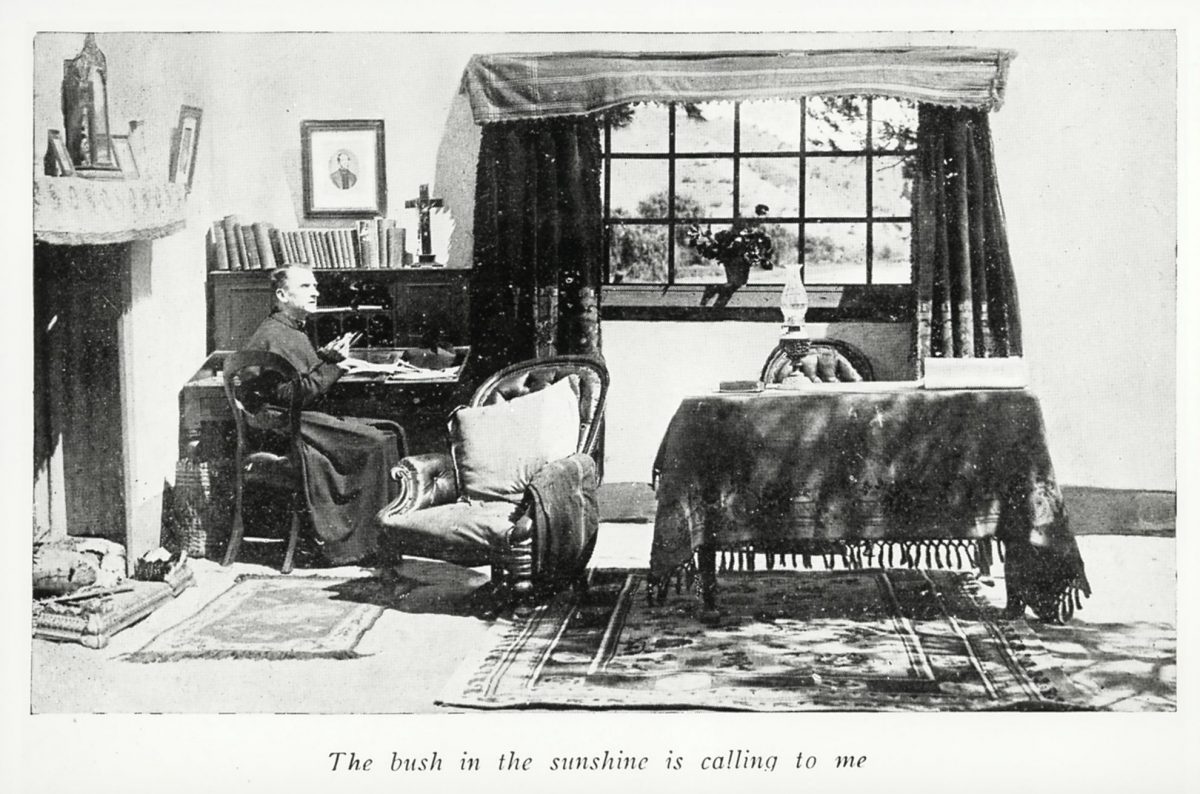
Bernard O’Reilly’s books on Irish rural life were filmed by Charles Chauvel as Sons of Matthew (1949).
The most atmospheric of movies about Australian Catholic life is Fred Schepesi’s The Devil’s Playground (1976) (trailer). His picture of the boys at a juniorate in 1953 was based on his own experience but the portrayal of events in the brothers’ commonroom is fanciful.
The 1994 movie Mary, starring Lucy Bell, told the story of Mary MacKillop (clip), while the 1999 Paul Cox film Molokai starred David Wenham as Father Damien (trailer; full movie).
Mel Gibson’s 2004 The Passion of the Christ showed Jesus’s last days in an ultrarealist style (trailer)
(More details in ch. 12 of Peter Malone’s Screen Priests; see also his large archive of film reviews)
The best-known Catholic TV series was Brides of Christ (ABC TV, 1991), about nuns in the tumultuous times of the 1960s. (clip) The 2014 series The Devil’s Playground was a sequel to the 1976 movie and dealt with the sexual abuse crisis.
See also the page of Podcasts and Videos.
Music
When Fr Therry arrived in 1820, he found a small choir already in operation, trained by Catherine Fitzpatrick. St Mary’s choir has continued to the present day and is Australia’s oldest musical institution. The Cathedral’s director of music around 1900, the noted composer and conductor John Albert Delany, reintroduced plainsong and unaccompanied polyphony.The singing of chant has remained popular in parishes.
In days when performance culture was widespread, even small parishes sometimes had very ambitious musical programs, such as at Sunny Corner near Lithgow in 1898.
When Pius X decreed in 1903 that church music should favour Gregorian Chant and Renaissance polyphony over a modern operatic style, Cardinal Moran decided the decree did not apply in Australia as it was a mission country.
Lucy Chambers, daughter of the Catholic Town Clerk of Sydney, was Australia’s first international star, as prima donna contralto assoluta at La Scala in 1865. Soprano Joan Hammond achieved international operatic fame in the 1950s. At a more popular level, “Killarney Kate” entertained Melbourne streetgoers in the 1910s and 20s. Sister Janet Mead‘s rock version of the Lord’s Prayer reached no. 3 on the Australian Singles Chart in 1973 and sold one and a half million copies.
In 1939 the Vienna Mozart Boys Choir, stranded in Australia on the outbreak of war, was given refuge by Archbishop Mannix as the choir of his cathedral. The cathedral was later the centre of the diverse musical activities of its choirmaster Fr Percy Jones.
Conductor Bernard Heinze was the most influential person in Australain music in the mid-twentieth century, as the ABC’s Director-General of Music and Director of the NSW Conservatorium. Richard Divall was a leading operatic conductor who also worked to recover early Australian music.
In many suburbs and country towns, the nuns were long the main teachers of music, to both Catholics and others, and gave generations of students their basic music education.
Around 1960, the poet James McAuley and the composer Richard Connolly collaborated on a number of hymns included in the Living Parish Hymn Book (audio of 1964 recording) (more). Classics include ‘By your kingly power’, ‘In faith and hope and love’ and ‘Help of Christians guard this land‘. McAuley also collaborated on a Symphony for Voices for unaccompanied choir with the composer Malcolm Williamson, later Master of the Queen’s Music.

The instrument most essential to church music is the organ. The Organ Historical Trust of Australia maintains an annotated list.
One of Australia’s most remote organs, donated by the Nazi government to Kalumburu mission in the Kimberley, was destroyed by a Japanese bombing raid in 1943.
Even those who never entered a church could not escape the bells.
Thanks to R.J. Stove for advice on the music section.

